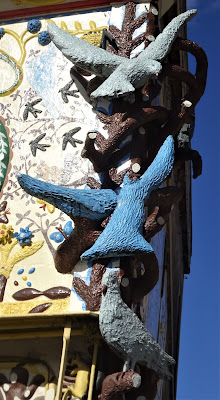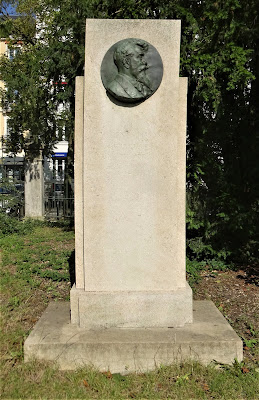Au Petit Paris was originally a small shop run by Marcel Dhièvre (1898-1977) and his second wife Constance. It was on meeting an Italian painter-decorator named Radici that his imagination was changed, and after World War II, when Marcel and his wife came to live at 478 Ave de la République, in La Noue district of the town, that he began a task that was to last for at least thirty years: decorating his house, transforming it into the art brut showpiece that it now is. The prominent frontal view of the Tour Eiffel and the Arc de Triomphe are testimony to his many trips to Paris to purchase merchandise for the shop. For his art, children in the neighbourhood helped him to collect 'rubbish' from local dumps, bits of broken crockery, pieces of glass, etc. The media became interested in his work in the seventies, although after his death the house began to fall into decay. However, in 1984 the house was declared a 'monument historique', in 1994 Katie Couprie bought the house and began reparations, and since 2018 it has become a 'Bar culturel'. The first image is of the front page of the sixteen-page booklet Il était une fois...au Petit Paris, published by L'Association Au Petit Paris.
30 September 2021
29 September 2021
Sheela Na Gig (sculpture of weird female genitalia), Bruyères-et-Montbérault (02), Aisne (02)
'So we're going to see a cunt on a church', my partner Penny remarked rather than questioned as I put my foot down out of Épernay towards Reims and beyond. Yes, indeed we were, and I'd for a few years had the intention of viewing this Sheela (exaggerated cunt and also in this particular example exaggerated (open rather than puckered) arsehole) on the exterior of L'Église Notre-Dame in Bruyères-et-Montbérault. Most Sheela Na Gigs are in Ireland (101) and the UK (45), but this is a splendid French version. I include the male sculpture on Bourges cathedral just for amusement.
Alexis Piron, Dijon (21), Côte-d'Or (21)
I mentioned Alexis Piron (1689-1773) a few posts ago, but was interested to see a Rue Piron (dedicated to Alexis or his great-nephew Eugène, I wondered) in Dijon. Sure enough, this is the house where the poet Alexis was born: great to see another tribute to this forgotten writer.
Léon Tolstoï and Ivan Tourgueniev, Dijon (21), Côte-d'Or (21)
Or Leo Tolstoy and Ivan Turgenev in English. So, they stayed at Hôtel de La Cloche, Dijon (now with a 'Grand' added) between 9 and 14 March 1857. I can't find a narrative behind this, but if anyone can give me a link I'd appreciate it.
26 September 2021
Françoise Grange, Amplepuis (69), Rhône (69)
Men grow up still believing in ancient customs: if they didn't they'd be cutting themselves off from their society. What they do is in 'good faith', they remain persuaded that women are inferior, witches or prostitutes, unworthy of respect. Women are to be feared, so it is necessary to tame them, dominate them, subject them to male wishes and punish them. 'Née Fille' is an extremely powerful argument in favour of the freedom of women, of their resistance to men's barbarities, and is a deeply moving experience, surely especially today when women in Afghanistan are returning to a horrific life which existed centuries ago?
The exhibits are accompanied by poems, but if it would be inappropriate for me to translate them. Suffice to say that we (yes, men too!) should all be feminists now. If not, there's no hope.
Eugène Piron, Dijon (21), La Côte-d'Or (21)
Another tribute in the Jardin Darcy. Sculptor Eugène Piron (1875-1928) was born in Dijon and died in Salon-de-Provence and was awarded the Prix de Rome in 1903. He sculpted many monuments, although perhaps the most interesting here is that of his bust to his fascinating great-uncle, the poet Alexis Piron in the Jardin de l'Arquebuse in Dijon, whose reputation for his youthful erotic Ode à Priape was to dog him for the rest of his life.
Rachel Feinstein, Dijon (21), La Côte-d'Or (21)
Rachel Feinstein's Puritan's Delight (2013). In front of this sculpture in the Jardin Darcy in Dijon is a plaque stating that Feinstein deliberately moves away from modernism to question and explore the history of eighteenth and nineteenth century European art. No social criticism or comment on the state of the modern world, but a 'rich, baroque, sophisticated iconography'. Uncluttered, monochrome, such as this example, a battered carriage with its wheel axles pointing upwards.
Henry Darcy, Dijon (21), La Côte-d'Or (21)
The Jardin Darcy is Dijon's first public garden, and dedicated to hydraulic engineer Henry Darcy (1803-58). On this site Darcy constructed a reservoir in 1838 to supply the city with drinking water. The architect Félix Vionnois built a neo-Renaissance garden here in 1880. Another tribute is the monument at the top of the garden by Émile Sagot, with its bust of Darcy.
Famously, Christian-Jaque's 1966 film La Seconde Vérité, starring Michèle Mercier and Robert Hossein, contains a scene shot here.
Auguste Laurent in Langres (52), Haute-Marne (52)
Auguste Laurent (1807-53) was a chemist born near Langres and was a precursor to modern organic chemistry and atomic theory.
Jean (or Jehan) Tabourot in Langres (52), Haute-Marne (52)
Jehan Tabourot (1520-95), who was born in Dijon and died in Langres, is also known under his anagram Thoinot Arbeau. That isn't the only unusual thing about a fascinating man who is apparently only openly remembered in Langres by a street name: Tabouret was a printer, a canon, a dance theorist and historian who wrote a few intruiguing books. He is perhaps best known for his Orchésographie (1588), which is written as a conversation between the narrator and the student and contains illustraions of dance steps. He also wrote the Calandrier des bergers, thought to bring good luck, and which people are said to have put under their pillows at night to ward off evil.
24 September 2021
Jeanne Mance in Langres (52), Haute-Marne (52)
Jeanne Mance (1606-73), who was born in Langres and died in Montréal, the city she co-founded (then named Ville-Marie) in 1642. Where her statue is in Langres was where she was baptised, where L'Église Saints Pierre et Paul was, and Jean Cardot's statue (1968) is placed where the baptismal fonts were. She left Langres in 1640, responding to a (religious) 'mission', and in 1641 left La Rochelle in a large ship. She arrived in Québec after three months, and the then deserted island of 'Ville-Marie' was founded. She died in Montréal.
The house where Jeanne Mance was born.
Denis Diderot in Langres (52), Haute-Marne (52)
Denis Diderot (1713-84) was born in Langres and died in Paris. His statue in his native town in what is now Place Diderot was erected one hundred years after his death: Diderot is everywhere in the town, as he should be but he has obviously become a victim of the tatty tourist industry. Interestingly, though, the house where he was born is now a Maison de Presse on the ground floor. In 2013, three hundred years after Diderot's birth, the mayor of the town inaugurated La Maison des lumières Denis Diderot, which was originally a building constructed in 1580 by Nicolas Ribonnier and given to La Société Archéologique de Langres by the Breuil de Saint Germain in 1923.




























































